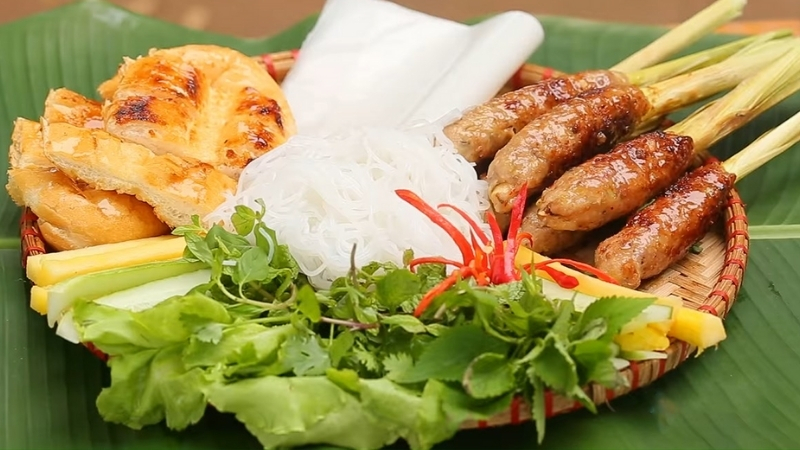Da Nang’s coastal location has played a pivotal role in shaping its cuisine, creating a rich tapestry of flavors and culinary traditions. From the abundance of fresh seafood to the incorporation of local herbs and spices, the coastal environment has profoundly influenced the city’s gastronomy. Immerse yourself in the culinary heritage of Da Nang through the Jolie Danang Cooking Class, an immersive experience that takes you on a journey of exploration and discovery.

I. The Bounty of the Sea:
1. Fresh Seafood as a Culinary Foundation
- Sourcing from the South China Sea: Da Nang’s proximity to the South China Sea grants access to a wide variety of fish, shrimp, and other seafood.
- Culinary Integration: Seafood is a staple ingredient in many traditional Da Nang dishes, reflecting its coastal identity.
- Culinary Techniques: Fresh seafood is often prepared using lighter cooking methods, preserving its delicate flavors and textures.
2. Prominent Seafood Dishes
- Cao Lau: A quintessential Da Nang dish featuring rice noodles, pork, and fresh herbs, often served with a side of crispy wontons.
- Mi Quang: A flavorful noodle soup made with turmeric-infused broth, topped with shrimp, pork, and fresh vegetables.
- Banh Xeo: A crispy rice pancake filled with a variety of ingredients, including shrimp, pork, and bean sprouts.
3. Fishing Traditions and Techniques
- Local Fishing Communities: Explore the traditions and practices of local fishing communities in Da Nang.
- Fishing Methods: Learn about various fishing techniques used by local fishermen, including hook and line, nets, and traps.
- Impact on Cuisine: Understand how fishing practices have influenced the culinary traditions of Da Nang.
II. Local Ingredients and Culinary Techniques:
1. Emphasis on Freshness
- Local Markets: Visit bustling local markets, where vendors display an array of fresh produce, herbs, and seafood.
- Seasonal Ingredients: Da Nang’s cuisine celebrates the use of seasonal ingredients, ensuring peak flavor and quality.
- Preserving Traditions: Learn about traditional methods for preserving and storing ingredients, such as pickling and drying.
2. Unique Herbs and Spices
- Tropical Climate: Da Nang’s coastal climate fosters the growth of various herbs and spices, adding distinct flavors to local dishes.
- Common Herbs: Lemongrass, mint, and basil are frequently used herbs that impart fragrance and freshness to dishes.
- Spice Blends: Explore the art of creating spice blends, combining different spices to create complex flavor profiles.
3. Cooking Techniques
- Steaming and Grilling: Lighter cooking methods, such as steaming and grilling, are preferred to preserve the natural flavors of ingredients.
- Stir-Frying: Stir-frying is a popular technique used to quickly cook vegetables, seafood, and meat, retaining their crispness.
- Deep-Frying: Deep-frying is often used to create crispy textures and golden-brown finishes in dishes.
III. Jolie Danang Cooking Class: An Immersive Culinary Experience:
1. Hands-On Learning:
- Interactive Workshops: Participate in hands-on workshops that guide you through the preparation of authentic Vietnamese dishes.
- Expert Chefs: Learn from experienced chefs who provide insights into traditional cooking techniques and culinary secrets.
- Cultural Exchange: Engage in cultural exchange with local chefs and fellow participants, sharing culinary knowledge and experiences.
2. Market Visits:
- Exploration of Local Markets: Visit vibrant local markets to select fresh ingredients and learn about the diversity of local produce.
- Ingredient Sourcing: Discover where local chefs source their ingredients and how to choose the best quality items.
- Seasonal Availability: Understand the importance of seasonal availability and how it influences the culinary calendar.
3. Cooking Classes:
- Step-by-Step Instructions: Follow step-by-step instructions from experienced chefs to create authentic Vietnamese dishes.
- Recipe Variations: Learn different variations of popular dishes, exploring how regional influences and personal preferences shape culinary traditions.
- Tasting and Feedback: Enjoy the fruits of your labor by tasting your creations and receiving feedback from chefs.
IV. The Influence of the Coastal Environment on Da Nang’s Culinary Identity:
1. Coastal Flavors:
- Seafood as a Primary Ingredient: Da Nang’s coastal location provides access to an abundance of fresh seafood, making it a prominent feature in local cuisine.
- Herbs and Spices: The coastal climate nurtures a variety of herbs and spices that contribute unique flavors to Da Nang’s dishes.
- Cooking Techniques: Lighter cooking methods, such as steaming and grilling, preserve the delicate flavors and textures of seafood.
2. Cultural Exchange:
- International Influences: Da Nang’s coastal location has facilitated cultural exchange, resulting in the incorporation of international culinary influences.
- Maritime Trade: Historical maritime trade routes brought new ingredients and cooking techniques to Da Nang, enriching its culinary landscape.
- Fusion Cuisine: Explore fusion dishes that blend traditional Vietnamese flavors with international influences.
3. Culinary Evolution:
- Preserving Traditions: Da Nang’s coastal location has contributed to the preservation of traditional culinary practices and recipes.
- Adapting to Changing Times: However, the city’s cuisine has also evolved to adapt to changing tastes and preferences.
- Contemporary Interpretations: Discover contemporary interpretations of classic Vietnamese dishes, reflecting modern culinary trends.
FAQs:
1. Q: What is the main focus of the Jolie Danang Cooking Class?
- A: The focus is on providing an immersive culinary experience, allowing participants to learn about the influence of Da Nang’s coastal location on its cuisine.
2. Q: What activities can participants expect during the cooking class?
- A: Participants will visit local markets, learn traditional cooking techniques, and prepare authentic Vietnamese dishes under the guidance of experienced chefs.
3. Q: What are some of the unique ingredients used in Da Nang cuisine?
- A: Common ingredients include fresh seafood, locally grown herbs and spices, and seasonal produce, all influenced by the coastal location.
4. Q: Which cooking techniques are commonly employed in Da Nang cuisine?
- A: Lighter cooking methods such as steaming and grilling are prevalent, along with stir-frying and deep-frying for certain dishes.
5. Q: How has Da Nang’s coastal location influenced its culinary evolution?
- A: The coastal environment has provided an abundance of fresh seafood and unique local ingredients, shaping Da Nang’s culinary identity and facilitating cultural exchange.
Conclusion:
Seafood Bounty: Da Nang’s proximity to the South China Sea provides a plethora of fresh seafood, making it a central culinary component.
Local Ingredients: The coastal climate nurtures a diverse array of herbs and spices, contributing unique flavors to local cuisine.
Culinary Techniques: Lighter cooking methods preserve the delicate flavors and textures of seafood, while stir-frying and deep-frying add variety.
Coastal Influence: Da Nang’s coastal location has facilitated cultural exchange, incorporating international flavors and evolving culinary traditions.
Jolie Danang Cooking Class: The immersive experience allows participants to explore Da Nang’s coastal culinary influences through market visits, cooking lessons, and hands-on preparation of authentic dishes.
Culinary Journey: Immerse yourself in the captivating flavors of Da Nang’s coastal cuisine, celebrating the bounty of the sea, the vibrant local ingredients, and the expertise of experienced chefs.

Leave a reply